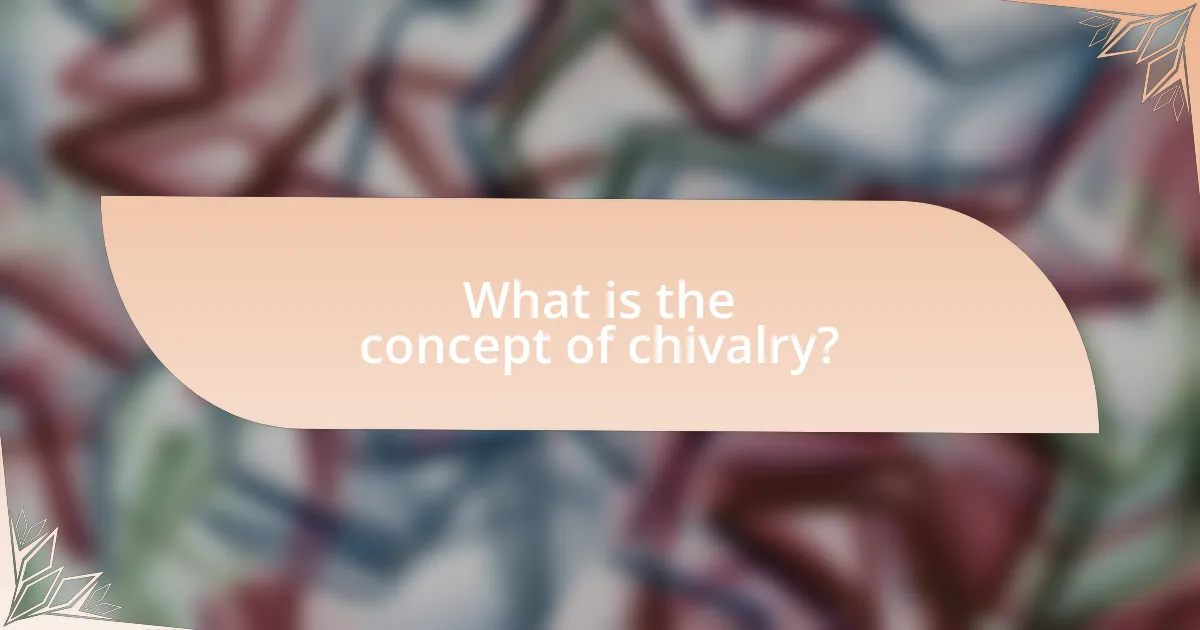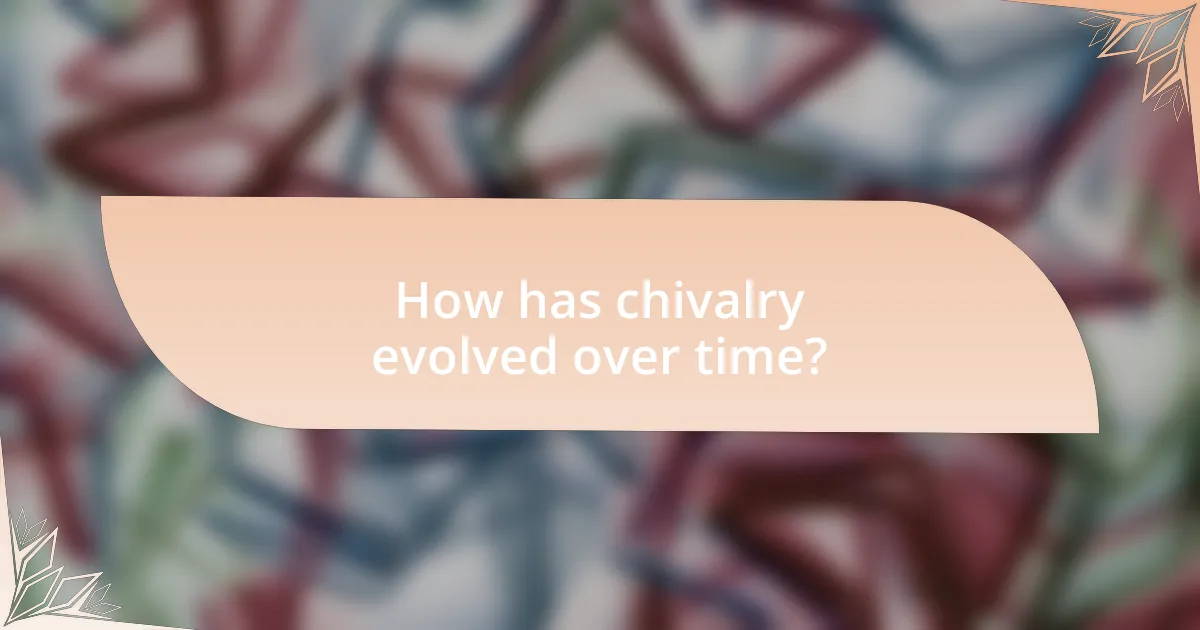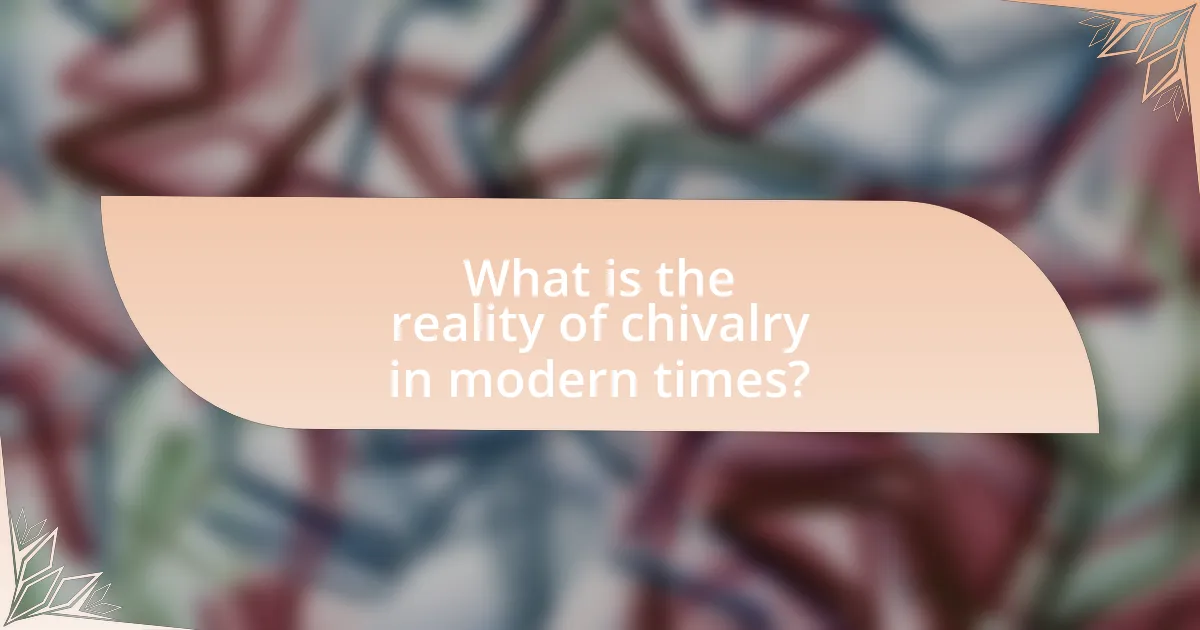The article examines the evolution of chivalry, tracing its origins from a medieval code of conduct for knights to its modern interpretations in contemporary society. It outlines the key characteristics of early chivalric codes, including bravery, honor, loyalty, and courtly love, and discusses how the feudal system and historical events like the Crusades influenced these ideals. The article also explores the transformation of chivalry over time, highlighting its adaptation to modern values of equality and mutual respect, while addressing criticisms of traditional chivalric ideals. Additionally, it provides insights into practical applications of chivalry today and the lessons learned from its historical context that can inform current social norms.

What is the concept of chivalry?
The concept of chivalry refers to a code of conduct associated with the medieval institution of knighthood, emphasizing virtues such as bravery, honor, and respect for women. Historically, chivalry emerged in the 12th century as a response to the feudal system, where knights were expected to protect their lords and uphold justice. The ideals of chivalry were further popularized by literature and courtly traditions, which portrayed knights as noble figures who demonstrated loyalty, courage, and courtesy. This code not only shaped the behavior of knights but also influenced societal norms regarding honor and moral conduct during the Middle Ages.
How did chivalry originate in medieval society?
Chivalry originated in medieval society as a code of conduct for knights, emphasizing virtues such as bravery, honor, and respect for women. This code emerged during the 9th and 10th centuries, influenced by the feudal system and the need for knights to uphold loyalty to their lords while also protecting the vulnerable. Historical texts, such as the “Song of Roland,” illustrate the ideals of chivalry, showcasing the expectation for knights to demonstrate valor in battle and integrity in their personal conduct. The Church also played a significant role in promoting chivalric values, aligning them with Christian teachings, which further solidified the concept within medieval culture.
What were the key characteristics of early chivalric codes?
Early chivalric codes were characterized by principles such as bravery, honor, loyalty, and courtly love. These codes emerged in the medieval period, primarily among the knightly class, and dictated the conduct expected of knights in both warfare and social interactions. For instance, the concept of honor required knights to uphold their reputation and defend the weak, while loyalty emphasized fidelity to one’s lord and comrades. Additionally, courtly love introduced a romantic ideal that influenced social behavior and relationships, promoting respect and admiration for women. Historical texts, such as “The Song of Roland” and “The Chanson de geste,” illustrate these characteristics, showcasing the values that shaped the knightly ethos during the era.
How did the feudal system influence the development of chivalry?
The feudal system significantly influenced the development of chivalry by establishing a hierarchical structure that emphasized loyalty, service, and martial prowess among the nobility. Under feudalism, knights were granted land in exchange for military service to their lords, which created a code of conduct that prioritized honor, bravery, and protection of the weak, foundational elements of chivalric ideals. This relationship between lords and vassals fostered a culture where the virtues of chivalry were not only expected but also rewarded, leading to the formalization of chivalric codes in the 12th century, such as those articulated by the Church and literature of the time. Historical texts, like the “Song of Roland,” illustrate how these codes were intertwined with feudal obligations, reinforcing the notion that a knight’s duty was to uphold the values of loyalty and honor in both warfare and peacetime.
What ideals are associated with chivalry?
The ideals associated with chivalry include bravery, honor, loyalty, courtesy, and a sense of duty to protect the weak. These principles were foundational to the knightly code of conduct during the medieval period, emphasizing the importance of moral integrity and ethical behavior in both personal and social contexts. Historical texts, such as “The Song of Roland,” illustrate these ideals by depicting knights who embody these virtues in their quests and battles, reinforcing the cultural significance of chivalry in shaping societal norms and expectations.
How do honor and loyalty define chivalric behavior?
Honor and loyalty are foundational elements that define chivalric behavior, as they dictate the moral and ethical standards by which knights and noblemen operated. Honor represents a commitment to uphold personal integrity and reputation, while loyalty signifies unwavering allegiance to one’s lord, comrades, and the ideals of knighthood. Historical texts, such as “The Song of Roland,” illustrate how knights were expected to demonstrate these virtues through acts of bravery and fidelity, reinforcing the societal expectation that chivalric individuals would prioritize honor and loyalty above personal gain. This adherence to honor and loyalty not only shaped individual conduct but also influenced the broader cultural understanding of chivalry during the medieval period.
What role did courtly love play in the chivalric ideal?
Courtly love was integral to the chivalric ideal, serving as a guiding principle that shaped the behavior and values of knights. This concept emphasized the importance of romantic devotion and noble conduct towards women, often elevating the status of the lady to a near-divine level. Historical texts, such as those by troubadours in the 12th century, illustrate how courtly love inspired knights to perform heroic deeds and uphold virtues like loyalty, honor, and bravery, all of which were essential to the chivalric code. The interplay between courtly love and chivalry fostered a culture where personal sacrifice and moral integrity were celebrated, reinforcing the notion that true knighthood was not only about martial prowess but also about the pursuit of love and respect for women.

How has chivalry evolved over time?
Chivalry has evolved from a medieval code of conduct for knights into a broader social ethos emphasizing respect, honor, and courteous behavior. Initially, chivalry was characterized by martial prowess and loyalty to one’s lord, as seen in the 12th-century writings of troubadours and the Code of Chivalry, which outlined virtues such as bravery, honor, and protection of the weak. Over time, particularly during the Renaissance, the concept expanded to include ideals of courtly love and gentlemanly behavior, reflecting changing societal values. By the 19th century, chivalry began to be associated with romantic notions of gallantry and gentlemanliness, as popularized by literature and cultural movements. Today, chivalry is often interpreted as a form of respect and equality in interpersonal relationships, moving away from its original martial connotations to encompass modern values of consent and mutual respect.
What historical events influenced the transformation of chivalry?
The transformation of chivalry was significantly influenced by the Crusades, the rise of centralized monarchies, and the decline of feudalism. The Crusades (1096-1291) introduced knights to new cultures and ideals, emphasizing martial prowess and religious devotion, which reshaped the chivalric code. The establishment of centralized monarchies in the late medieval period diminished the power of feudal lords, leading to a more unified legal system and the promotion of loyalty to the crown over individual lords. Additionally, the decline of feudalism in the late 15th century reduced the traditional role of knights, prompting a shift in chivalric values towards courtly behavior and service to the state. These events collectively redefined chivalry from a strictly martial code to one encompassing broader social and moral responsibilities.
How did the Crusades impact the perception of chivalry?
The Crusades significantly transformed the perception of chivalry by intertwining martial valor with religious devotion. As knights participated in these holy wars, the ideals of chivalry evolved to emphasize not only bravery and honor but also the moral obligation to protect Christendom. This shift is evidenced by the emergence of the concept of “holy war,” where knights were seen as defenders of the faith, thus elevating their status and reinforcing the notion that chivalric duties included spiritual responsibilities. Additionally, the narratives surrounding the Crusades, such as the valorous deeds of figures like Godfrey of Bouillon, further romanticized the chivalric code, embedding it deeply within the cultural consciousness of medieval Europe.
What changes occurred during the Renaissance regarding chivalric values?
During the Renaissance, chivalric values shifted from a focus on martial prowess and feudal loyalty to an emphasis on humanism, individualism, and courtly behavior. This transformation was influenced by the revival of classical learning and the rise of a more secular society, which prioritized personal virtue and intellectual achievement over traditional knightly conduct. For example, literature from this period, such as Baldassare Castiglione’s “The Book of the Courtier,” highlighted the importance of grace, eloquence, and moral integrity in a gentleman, reflecting a broader cultural movement that valued personal character and education alongside the ideals of chivalry.
How did literature shape the ideals of chivalry?
Literature significantly shaped the ideals of chivalry by providing narratives that defined and popularized the virtues associated with knightly behavior, such as bravery, loyalty, and honor. Works like “The Song of Roland” and the Arthurian legends illustrated the expectations of knights, emphasizing their roles as protectors of the weak and champions of justice. These texts not only entertained but also served as moral guides, influencing societal norms and the conduct of knights in medieval Europe. The portrayal of chivalric heroes in literature established a framework for the ideal knight, which was then emulated in real-life conduct, thereby reinforcing the chivalric code within the culture of the time.
What are some notable works that depict chivalric themes?
Notable works that depict chivalric themes include “Le Morte d’Arthur” by Sir Thomas Malory, which chronicles the legends of King Arthur and his knights, emphasizing ideals of bravery, honor, and loyalty. Another significant work is “The Song of Roland,” an epic poem that illustrates the values of feudal loyalty and heroism in the context of the Battle of Roncevaux Pass. Additionally, “Don Quixote” by Miguel de Cervantes parodies chivalric ideals while also exploring the complexities of honor and romanticism in a changing society. These works collectively reflect the evolution of chivalric ideals from noble aspirations to critical examinations of their relevance.
How did these literary representations affect societal views on chivalry?
Literary representations significantly shaped societal views on chivalry by idealizing and promoting the values associated with knightly conduct, such as bravery, honor, and courtly love. Works like “Le Morte d’Arthur” by Sir Thomas Malory and “The Song of Roland” emphasized the noble qualities of knights, which led to a cultural reverence for chivalric ideals. These narratives not only influenced the behavior of the nobility but also established a framework for societal expectations regarding masculinity and moral conduct during the medieval period. As a result, the portrayal of chivalry in literature became a benchmark for ethical behavior, reinforcing the notion that knights should embody these virtues in their actions and interactions.

What is the reality of chivalry in modern times?
The reality of chivalry in modern times is characterized by a blend of traditional values and contemporary interpretations, often manifesting in acts of respect, courtesy, and protection, particularly towards women. While the historical concept of chivalry was rooted in the knightly code of conduct, modern chivalry adapts these ideals to fit current societal norms, emphasizing equality and mutual respect. For instance, surveys indicate that many people still value chivalrous behaviors, such as holding doors open or offering assistance, but these actions are increasingly viewed through the lens of gender equality, where both men and women engage in such behaviors. This evolution reflects a shift from a rigid, gender-specific code to a more inclusive understanding of respect and kindness in interpersonal relationships.
How is chivalry perceived in contemporary society?
Chivalry is perceived in contemporary society as a complex blend of traditional values and modern interpretations, often viewed through the lens of gender equality and social justice. Many individuals appreciate the ideals of chivalry, such as respect, honor, and protection, but they also critique its historical associations with patriarchy and gender roles. Surveys indicate that while a significant portion of the population values acts of kindness and respect traditionally linked to chivalry, there is a growing demand for these behaviors to be inclusive and equitable, reflecting contemporary values of mutual respect and partnership. For instance, a 2021 study published in the Journal of Social Issues found that 68% of respondents believed that chivalrous behavior should be practiced by all genders, highlighting a shift towards a more egalitarian understanding of these ideals.
What are the criticisms of chivalric ideals today?
Criticisms of chivalric ideals today include their reinforcement of gender stereotypes and the promotion of outdated notions of masculinity. Critics argue that these ideals often depict men as protectors and women as passive recipients of protection, which can perpetuate inequality. Additionally, chivalric ideals are seen as limiting, as they can pressure men to conform to a narrow definition of honor and bravery, while women may feel constrained by the expectation of needing protection. This perspective is supported by contemporary gender studies, which highlight how traditional chivalry can hinder progress toward gender equality by maintaining hierarchical structures in relationships and society.
How do modern interpretations of chivalry differ from historical ones?
Modern interpretations of chivalry emphasize equality and mutual respect, contrasting with historical chivalry, which often revolved around male dominance and hierarchical social structures. Historically, chivalry was a code of conduct for knights, focusing on martial prowess, loyalty to one’s lord, and protection of women, often reflecting feudal values. In contrast, contemporary views advocate for gender equality, where chivalrous behavior includes respect for all individuals, regardless of gender, and promotes social justice. This shift is evident in modern discussions around consent and mutual support, highlighting a more inclusive understanding of honor and respect compared to the traditional, often patriarchal, interpretations of chivalry.
What practical applications of chivalry exist today?
Practical applications of chivalry today include acts of courtesy, respect, and protection, particularly in social interactions and relationships. For instance, holding doors open for others, offering assistance to those in need, and showing respect in communication reflect chivalric values. These behaviors promote positive social norms and contribute to a culture of kindness and respect. Studies indicate that such acts can enhance social cohesion and improve interpersonal relationships, demonstrating the relevance of chivalric principles in contemporary society.
How can individuals embody chivalric values in daily life?
Individuals can embody chivalric values in daily life by practicing respect, kindness, and integrity in their interactions with others. For instance, showing respect can manifest as actively listening to others, offering assistance to those in need, and treating everyone with dignity, regardless of their status. Historical examples, such as the code of conduct followed by knights in the Middle Ages, emphasize the importance of loyalty and honor, which can be reflected in modern relationships through trustworthiness and standing up for what is right. By integrating these values into everyday actions, individuals contribute to a culture of respect and honor, aligning with the foundational principles of chivalry.
What role does chivalry play in modern relationships and interactions?
Chivalry plays a significant role in modern relationships and interactions by promoting respect, courtesy, and equality between partners. In contemporary contexts, chivalric behaviors, such as holding doors open or offering assistance, are often viewed as gestures of kindness that enhance mutual respect. Research indicates that these behaviors can positively influence relationship satisfaction, as they foster a sense of appreciation and care. For instance, a study published in the Journal of Social and Personal Relationships found that acts of kindness and consideration, which align with chivalric ideals, correlate with higher levels of relationship satisfaction and emotional intimacy. Thus, chivalry, while evolving from its historical roots, continues to shape how individuals interact and build connections in modern society.
What lessons can be learned from the evolution of chivalry?
The evolution of chivalry teaches that ideals can transform over time, reflecting societal values and norms. Initially, chivalry emphasized martial prowess and loyalty, as seen in the medieval knightly code, which prioritized bravery and honor in battle. Over centuries, these ideals evolved to include virtues such as compassion, respect for women, and a sense of justice, indicating a shift towards moral and ethical considerations in personal conduct. Historical examples, such as the transition from the feudal system to more democratic societies, illustrate how chivalric values adapted to promote social responsibility and community service. This evolution underscores the importance of aligning personal conduct with contemporary ethical standards, demonstrating that values must evolve to remain relevant in changing social contexts.
How can understanding chivalry’s history inform current social norms?
Understanding chivalry’s history can inform current social norms by highlighting the evolution of values such as honor, respect, and duty towards others. Historically, chivalry emerged in the medieval period as a code of conduct for knights, emphasizing virtues like bravery and protection of the weak, which shaped societal expectations regarding gender roles and interpersonal relationships. For instance, the chivalric ideal of protecting women has influenced contemporary discussions about gender equality and respect in relationships, illustrating how historical frameworks can inform modern values. By examining these historical contexts, society can better understand the roots of current norms and potentially reshape them to promote more equitable interactions.
What best practices can be adopted from chivalric ideals in today’s world?
Best practices that can be adopted from chivalric ideals in today’s world include promoting respect, integrity, and service to others. These principles encourage individuals to treat others with dignity, uphold ethical standards, and contribute positively to their communities. For instance, the concept of respect can be seen in modern movements advocating for equality and social justice, reflecting the chivalric commitment to honor and protect those who are vulnerable. Additionally, integrity is essential in personal and professional relationships, fostering trust and accountability. Service to others, a core tenet of chivalry, is exemplified by volunteerism and community engagement, which enhance societal well-being. These practices not only align with historical chivalric values but also address contemporary social challenges, reinforcing their relevance today.